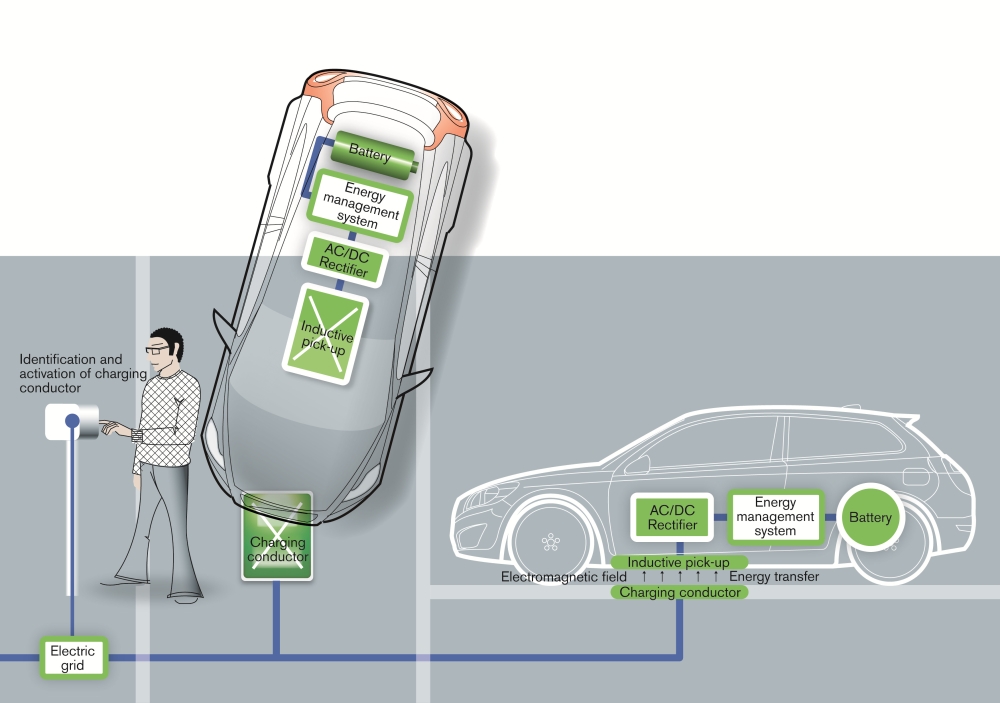
Inductive battery charging illustration from Volvo
EV automakers face an uphill road. Not only do they have to make great looking cars that offer all the amenities of their gas-engined equivalents, but they've also got to assuage public concerns about the EV charging infrastructure -- an infrastructure that lies largely outside their control. Now, Volvo is hoping to put customers' minds at ease with a new project to develop inductive charging for EVs.
For the project, Volvo has teamed up with Belgian tech outfit Flanders' Drive to create plates that recharge EV battery packs without the bother of plugging the vehicle into a conventional outlet. For testing purposes, Volvo is taking a bright, shiny, new Volvo C30 Electric to Flanders' Drive offices today, where the charging technology will be evaluated for speed and functionality. Charging the C30's 24 kWh battery pack is expected to take around an hour and 20 minutes.
Of course, induction charging isn't a new idea. It's been available for phones and other portable devices for years. Some tech firms are convinced that charging on-the-go for EVs is just around the corner, thanks to the possibility of embedding charging technology beneath roadways and parking spots. In fact, we've even seen at least one Korean EV prototype that relied exclusively on that kind of inductive charging, forgoing a battery altogether.
Given the scale of infrastructure development necessary to make some of those visions happen, we're not taking any bets. But there are two things we know for sure:
1. Going cordless is attractive to consumers; and
2. Volvo is launching this project just a few months before the Volvo C30 Electric arrives Europe.
No word on how the technology might roll out to individual consumers yet. We'll keep you apprised of developments down the road.
* * * * *
Volvo Car Corporation participates in a project for the development of inductive charging for electric cars
Volvo Car Corporation is participating in an inductive charging project. Together with Belgian technological and development specialists Flanders' Drive and others, Volvo Car Corporation is developing systems and methods that need neither power sockets nor charging cables. With inductive charging, energy is transferred wirelessly to the car's battery via a charging plate buried in the road surface.
"The aim is naturally that it should be as convenient as possible to own and use an electric car," explains Johan Konnberg, project manager from the Special Vehicles division of Volvo Car Corporation. A Volvo C30 Electric will be delivered to Flanders' Drive on May 19 to be modified for inductive charging. The handover also marks the formal starting signal for the project, which goes under the name of CED (Continuous Electric Drive). Other participants in addition to Volvo Car Corporation and Flanders' Drive, which is owned by the Belgian state, are bus manufacturer Van Hool and tram manufacturer Bombardier.
Wireless energy transfer
In inductive charging, a charging plate is buried in the ground, for instance in the driveway at home where the car is parked. The charging plate consists of a coil that generates a magnetic field. When the car is parked above the plate, energy from the plate is transferred without physical contact to the car's inductive pick-up. The energy that is transferred is alternating current. This is then converted into direct current in the car's built-in voltage converter, which in turn charges the car's battery pack. Charging a battery pack of the size fitted to the Volvo C30 Electric, 24 kWh, is expected to take about an hour and twenty minutes, if the battery is entirely discharged. The charging system to be evaluated is dimensioned for 20 kW.
Development and knowledge acquisition
Several car makers and technology companies are conducting research into this area but as yet there are no car manufacturers that can offer the market a finished product.
"There is not yet any common standard for inductive charging," says Johan Konnberg.
He emphasises the importance of being involved in development and learning about the technology in order to build up a solid bank of expertise in this area.
"One aspect of this project is to integrate this technology into the road surface and to take energy directly from there to power the car. This is a smart solution that is some way into the future," concludes Johan Konnberg.
The Volvo C30 Electric is part of Volvo Car Corporation' ambitious electrification strategy. It is as well-equipped, comfortable, sporty and safe as the standard car - while at the same time offering the driver a range of up to 150 kilometres per charge with zero carbon dioxide emissions.
Deliveries of the initial batch of 250 cars to selected customers in Europe will begin during the second half of 2011.













